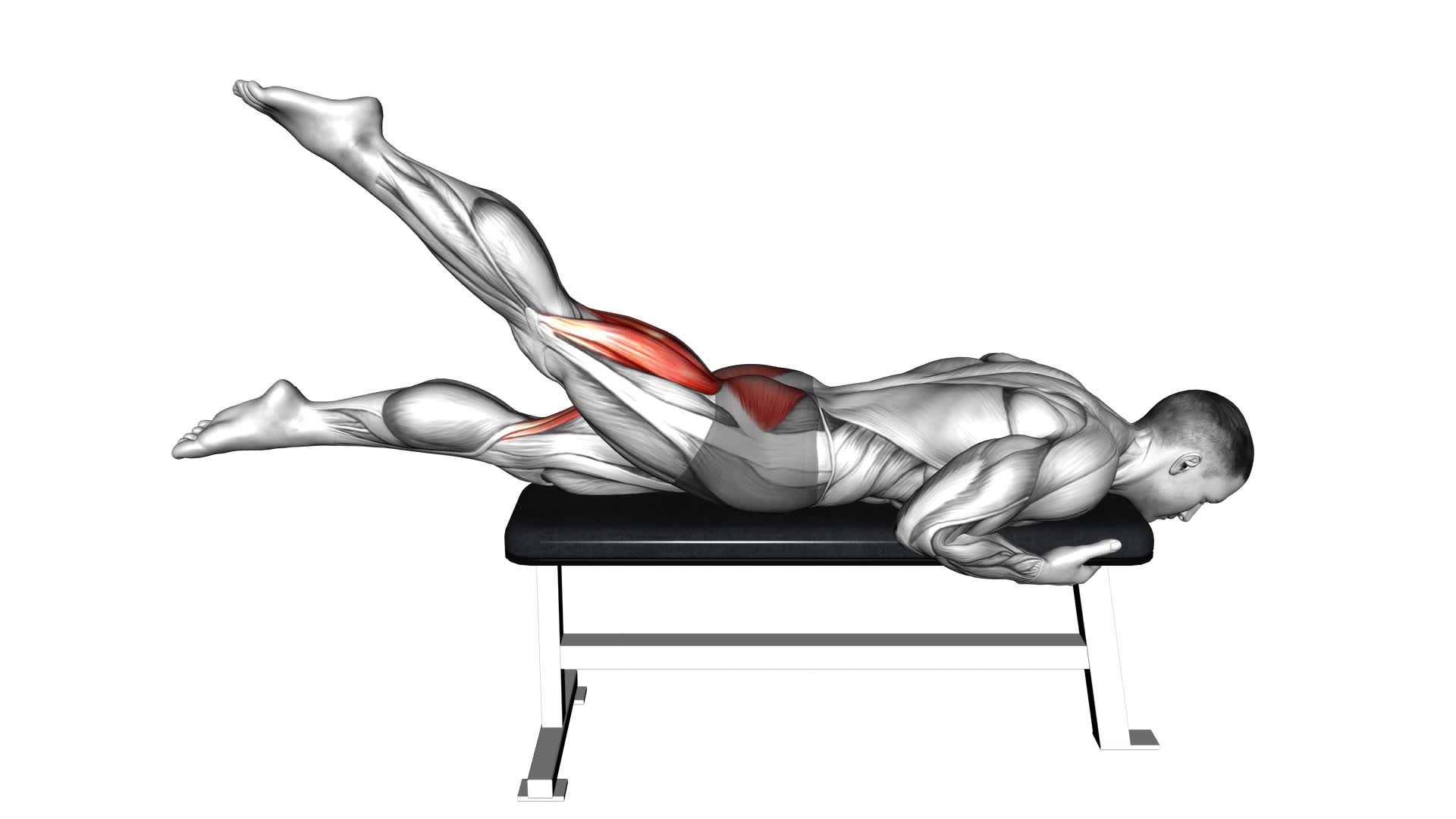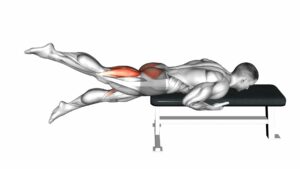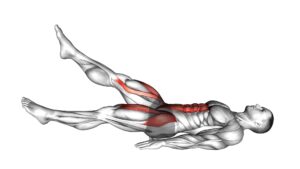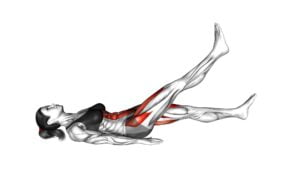Flutter Kicks – Video Exercise Guide & Tips

Are you looking to strengthen your core and tone your legs? Look no further than flutter kicks!
Watch This Exercise Video
This video exercise guide and tips will show you how to properly perform flutter kicks for maximum effectiveness.
Learn the benefits, proper form, variations, and common mistakes to avoid.
Get ready to feel the burn and achieve your fitness goals with flutter kicks!
Key Takeaways
- Flutter kicks are a highly effective exercise for targeting abs, lower abs, hip flexors, and quads.
- Flutter kicks engage multiple muscle groups simultaneously, improving core stability and coordination.
- They are a low-impact option for individuals with back or neck issues.
- Proper form is important, including keeping legs extended, avoiding lifting shoulders off the ground, and focusing on engaging core muscles.
Benefits of Flutter Kicks
To get the most out of flutter kicks, incorporate them into your workout routine for a range of benefits.
Flutter kicks are a highly effective exercise for your abs, offering unique advantages over other ab exercises. Unlike traditional crunches or sit-ups, flutter kicks target your lower abs, hip flexors, and quads. This makes them a great addition to any abdominal workout routine, helping to strengthen and tone these specific areas.
Compared to other ab exercises, flutter kicks provide a dynamic movement that engages multiple muscle groups simultaneously. This not only increases the intensity of your workout but also improves your overall core stability and coordination. Additionally, flutter kicks offer a low-impact option for individuals with back or neck issues, as they minimize strain on these areas.
To incorporate flutter kicks into your workout routine, start by lying flat on your back with your legs extended and hands by your sides. Lift your legs slightly off the ground and begin fluttering them up and down in a controlled motion. Aim for a steady pace and keep your core engaged throughout the exercise.
Proper Form for Flutter Kicks
Maintain proper form during flutter kicks by keeping your legs extended and your core engaged. To ensure you're performing flutter kicks correctly, avoid these common mistakes and follow these tips for proper form.
Firstly, avoid lifting your shoulders off the ground. This can strain your neck and decrease the effectiveness of the exercise. Keep your upper body relaxed and flat on the ground throughout the movement.
Secondly, resist the temptation to bend your knees. Flutter kicks should be done with straight legs, as this engages the lower abdominal muscles more effectively. By keeping your legs extended, you maximize the benefits of the exercise.
Additionally, focus on engaging your core muscles. Keep your abdominal muscles tight and your lower back pressed into the ground. This will stabilize your body and prevent excessive movement.
Lastly, maintain a controlled and steady pace. Flutter kicks should be performed with a controlled and deliberate motion. Avoid flailing or rushing through the movement, as this can lead to poor form and reduced effectiveness.
Variations of Flutter Kicks
Now let's explore some variations of flutter kicks to add variety and challenge to your workout routine. Here are five different ways you can incorporate flutter kicks into your core exercises:
- Side Plank Flutter Kicks: Start in a side plank position with your forearm on the ground and your body in a straight line. Lift your top leg and perform flutter kicks, keeping your core engaged and your hips stable.
- Weighted Flutter Kicks: Hold a dumbbell or a medicine ball between your feet while performing flutter kicks. This added resistance will increase the intensity and target your core muscles even more.
- Reverse Flutter Kicks: Lie on your stomach with your arms extended overhead. Lift both legs off the ground and perform flutter kicks in a reverse motion, focusing on engaging your lower back and glutes.
- Bent Knee Flutter Kicks: Instead of keeping your legs straight, bend your knees at a 90-degree angle while performing flutter kicks. This modification will engage your hip flexors and add an extra challenge to your core.
- Scissor Flutter Kicks: Start by lying on your back with your legs extended. Lift one leg up while keeping the other leg slightly off the ground. Alternate between lifting each leg, creating a scissor-like motion.
Incorporating these variations into your flutter kicks routine won't only spice up your workout but also target different muscle groups within your core. Give them a try and feel the burn!
Common Mistakes to Avoid During Flutter Kicks
Avoid these common mistakes when performing flutter kicks to get the most out of your core workout. Proper technique is crucial to maximize the benefits of this exercise and prevent potential injuries.
One common mistake is lifting your head and shoulders off the ground. This not only puts unnecessary strain on your neck, but it also reduces the engagement of your core muscles. Keep your head and shoulders relaxed and in contact with the ground throughout the exercise.
Another mistake to avoid is excessively arching your lower back. This can lead to lower back pain and diminish the effectiveness of the exercise. Keep your lower back pressed into the ground and engage your core to maintain proper form.
Lastly, avoid flaring your legs out to the sides. This not only reduces the engagement of your core muscles but also increases the risk of straining your hip flexors. Keep your legs straight and together, maintaining a controlled and steady movement.
Tips for Maximizing the Effectiveness of Flutter Kicks
To further enhance the effectiveness of your flutter kicks, focus on controlling your breathing throughout the exercise. Proper breathing technique not only helps to oxygenate your muscles, but it also aids in maintaining stability and control during the movement.
Here are some tips to maximize the effectiveness of your flutter kicks:
- Engage your core: Contract your abdominal muscles and keep your lower back pressed firmly against the ground. This will ensure that you're targeting the right muscles and avoiding strain on your lower back.
- Maintain a steady pace: Avoid rushing through the exercise. Slow and controlled movements will engage your muscles more effectively and prevent momentum from taking over.
- Keep your legs straight: Straightening your legs fully will engage your hip flexors and increase the intensity of the exercise.
- Don't rely solely on your legs: Incorporate your upper body by keeping your arms extended alongside your body or placing your hands underneath your glutes for support.
- Incorporate flutter kicks into a full body workout routine: Combine flutter kicks with other exercises that target different muscle groups to create a comprehensive full body workout. This will help you build strength and endurance throughout your entire body.
Frequently Asked Questions
How Many Calories Can I Burn by Doing Flutter Kicks?
You can burn calories by doing flutter kicks. The effectiveness of flutter kicks as a calorie-burning exercise depends on various factors such as your weight, intensity, and duration of the workout.
The constant movement of your legs engages multiple muscle groups, which can increase your heart rate and calorie expenditure. However, the exact number of calories burned will vary for each individual.
To get a more accurate estimate, consider using a fitness tracker or consulting a fitness professional.
Can I Do Flutter Kicks if I Have Lower Back Pain?
If you have lower back pain, you may want to consider modifying or finding alternatives for flutter kicks. The repetitive motion of flutter kicks can put strain on your lower back. It's important to listen to your body and avoid any exercise that exacerbates your pain.
Instead, you can try exercises like glute bridges or planks that engage your core without putting as much stress on your back.
Always consult with a healthcare professional before starting any new exercise routine.
Can Flutter Kicks Help Me Get Six-Pack Abs?
Yes, flutter kicks can help you get six-pack abs. By incorporating flutter kicks into your workout routine, you can target your abdominal muscles and strengthen them.
The technique involves lying on your back, raising your legs slightly off the ground, and alternating kicking motions. This exercise engages your core, helping to tone and define your abs.
In addition to working your abdominal muscles, flutter kicks also improve overall core stability and endurance.
How Often Should I Incorporate Flutter Kicks Into My Workout Routine?
To effectively incorporate flutter kicks into your workout routine, it's important to consider the frequency.
Flutter kicks can be done 2-3 times a week for optimal results. By incorporating them regularly, you can strengthen your core muscles and improve overall abdominal definition.
Flutter kicks engage your lower abs and hip flexors, making them a great addition to your routine. Remember to start with proper form and gradually increase the intensity to avoid injury.
Can Flutter Kicks Be Modified for Beginners or Those With Limited Mobility?
Yes, flutter kicks can be modified for beginners or those with limited mobility. There are modified variations of flutter kicks that can be done, such as bending the knees or using a stability ball for support.
Additionally, there are alternative exercises that can target similar muscle groups, such as leg lifts or seated knee raises.
It's important to listen to your body and choose the modifications or alternative exercises that work best for you.
Conclusion
In conclusion, flutter kicks are a highly effective exercise for targeting the core muscles and improving overall strength and stability. By maintaining proper form and avoiding common mistakes, you can maximize the effectiveness of flutter kicks.
Additionally, incorporating variations of this exercise can help to challenge and further strengthen your core. Remember to consult with a fitness professional before starting any new exercise routine to ensure proper technique and safety.

Author
Years ago, the spark of my life’s passion ignited in my mind the moment I stepped into the local gym for the first time. The inaugural bead of perspiration, the initial endeavor, the very first surge of endorphins, and a sense of pride that washed over me post-workout marked the beginning of my deep-seated interest in strength sports, fitness, and sports nutrition. This very curiosity blossomed rapidly into a profound fascination, propelling me to earn a Master’s degree in Physical Education from the Academy of Physical Education in Krakow, followed by a Sports Manager diploma from the Jagiellonian University. My journey of growth led me to gain more specialized qualifications, such as being a certified personal trainer with a focus on sports dietetics, a lifeguard, and an instructor for wellness and corrective gymnastics. Theoretical knowledge paired seamlessly with practical experience, reinforcing my belief that the transformation of individuals under my guidance was also a reflection of my personal growth. This belief holds true even today. Each day, I strive to push the boundaries and explore new realms. These realms gently elevate me to greater heights. The unique combination of passion for my field and the continuous quest for growth fuels my drive to break new ground.







